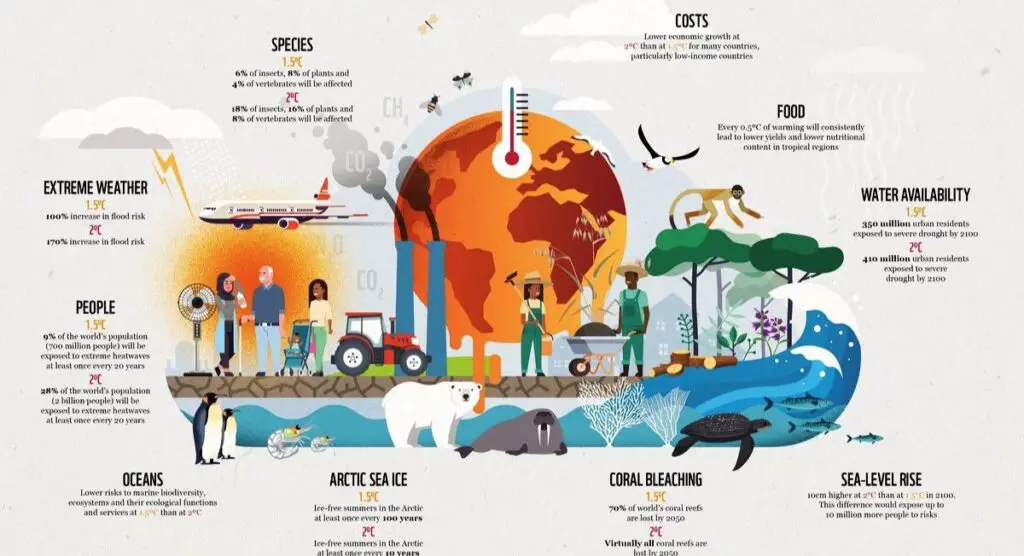Ecological Issuses : International Environmental Agreements, Climate Change
Ecological Issues : International Environmental Agreements and Climate Change
Ecological issues encompass the environmental challenges that affect the health of ecosystems, biodiversity, and human societies. These include deforestation, pollution, biodiversity loss, desertification, and most significantly, climate change. International cooperation through environmental agreements is critical in addressing these issues on a global scale.
1. International Environmental Agreements:
International environmental agreements (IEAs) are legally binding or voluntary pacts between countries aimed at addressing global environmental issues. These agreements establish frameworks for cooperation, set goals, and outline specific commitments for reducing ecological damage, protecting biodiversity, and promoting sustainable development.
Key Characteristics of International Environmental Agreements:
- Multilateral Cooperation:
- These agreements often involve multiple countries, acknowledging that environmental issues cross borders and require collective action.
- Example: The Paris Agreement, where over 190 countries have committed to reducing greenhouse gas emissions to combat climate change.
- Global Governance:
- International bodies such as the United Nations (UN) and its specialized agencies, like the UN Environment Programme (UNEP), often oversee and facilitate the creation and enforcement of these agreements.
- Example: The Convention on Biological Diversity (CBD), which is overseen by the UNEP, focuses on conserving global biodiversity.
- Legally Binding or Voluntary:
- Some agreements are legally binding, requiring signatories to adhere to their commitments, while others are voluntary but carry significant moral and political weight.
- Example: The Kyoto Protocol was a legally binding agreement to reduce greenhouse gas emissions, while the Paris Agreement allows for voluntary national commitments, with a review mechanism.
- Sustainable Development:
- Many IEAs focus on balancing environmental protection with economic development, recognizing that sustainability is key to long-term ecological health.
- Example: The 2030 Agenda for Sustainable Development and its Sustainable Development Goals (SDGs), especially Goal 13: Climate Action.
Key International Environmental Agreements :

- The Paris Agreement (2015):
- Objective: To limit global warming to well below 2°C above pre-industrial levels, with efforts to limit the temperature increase to 1.5°C.
- Key Features: Countries set Nationally Determined Contributions (NDCs), outlining their plans to reduce greenhouse gas emissions. The agreement encourages regular updates of these commitments every five years.
- Significance: It is the most comprehensive international framework to address climate change, involving nearly every country in the world.
- The Kyoto Protocol (1997):
- Objective: To reduce greenhouse gas emissions by industrialized countries to 5% below 1990 levels by 2012.
- Key Features: Legally binding emission reduction targets for developed countries, with flexibility mechanisms like emissions trading and the Clean Development Mechanism (CDM).
- Significance: It was the first significant global effort to curb greenhouse gas emissions, but it faced criticism for excluding developing countries and the U.S. from binding commitments.
- Convention on Biological Diversity (CBD, 1992):
- Objective: To conserve biological diversity, promote sustainable use of its components, and ensure fair sharing of benefits arising from the use of genetic resources.
- Key Features: Includes targets for protecting ecosystems, species, and genetic diversity, and addresses issues such as habitat destruction and overexploitation.
- Significance: It plays a vital role in conserving global biodiversity, especially in light of increasing habitat destruction and species extinction.
- Montreal Protocol (1987):
- Objective: To phase out the production and consumption of substances that deplete the ozone layer, such as chlorofluorocarbons (CFCs).
- Key Features: Legally binding with clear timelines for the elimination of ozone-depleting substances.
- Significance: It is one of the most successful international environmental agreements, significantly reducing the depletion of the ozone layer and preventing harmful UV radiation from reaching Earth.
- United Nations Convention to Combat Desertification (UNCCD, 1994):
- Objective: To combat desertification and mitigate the effects of drought, particularly in countries experiencing serious drought and desertification.
- Key Features: Focuses on sustainable land management and restoring degraded ecosystems.
- Significance: It addresses land degradation, which impacts food security, water availability, and rural livelihoods, particularly in arid and semi-arid regions.
- CITES (Convention on International Trade in Endangered Species, 1975):
- Objective: To ensure that international trade in wild animals and plants does not threaten their survival.
- Key Features: Regulates the trade of endangered species by categorizing them into appendices with varying degrees of protection.
- Significance: It helps curb illegal wildlife trade, which is a major contributor to species extinction.
- The Stockholm Convention on Persistent Organic Pollutants (2001):
- Objective: To eliminate or reduce the production and use of persistent organic pollutants (POPs), which are toxic chemicals that remain in the environment and accumulate in living organisms.
- Key Features: Phasing out harmful chemicals, like certain pesticides and industrial chemicals, and providing alternatives.
- Significance: It addresses long-term human and environmental health risks caused by these pollutants.
2. Climate Change:

Climate change refers to long-term shifts in temperature, weather patterns, and atmospheric conditions primarily caused by human activities, especially the burning of fossil fuels, deforestation, and industrial processes. These activities increase the concentration of greenhouse gases (GHGs), such as carbon dioxide (CO₂), methane (CH₄), and nitrous oxide (N₂O), in the atmosphere, trapping heat and leading to a range of environmental impacts.
Key Causes of Climate Change:

- Burning of Fossil Fuels:
- The combustion of coal, oil, and natural gas for energy production, transportation, and industry releases significant amounts of CO₂ into the atmosphere, contributing to the greenhouse effect.
- Deforestation:
- Forests act as carbon sinks, absorbing CO₂ from the atmosphere. Large-scale deforestation reduces this capacity and releases stored carbon back into the atmosphere.
- Agriculture:
- Agricultural practices, including livestock farming (which produces methane) and the use of nitrogen-based fertilizers, contribute to GHG emissions.
- Industrial Processes:
- Certain industrial activities, such as cement production and chemical manufacturing, emit GHGs and other pollutants that exacerbate climate change.
- Waste Management:
- Decomposing organic waste in landfills produces methane, a potent greenhouse gas, while improper waste management contributes to pollution and environmental degradation.
Key Impacts of Climate Change:

- Rising Global Temperatures:
- The average global temperature has already risen by about 1°C since pre-industrial times, with catastrophic consequences if it continues to rise beyond 1.5°C or 2°C.
- Melting Ice Caps and Rising Sea Levels:
- Melting polar ice caps and glaciers contribute to rising sea levels, which threaten coastal communities and ecosystems, leading to increased flooding, erosion, and displacement.
- Extreme Weather Events:
- Climate change is linked to more frequent and intense extreme weather events, including hurricanes, heatwaves, floods, and droughts, which cause widespread damage and disrupt livelihoods.
- Biodiversity Loss:
- Changes in climate patterns disrupt ecosystems, threatening the survival of species and leading to habitat loss, shifting migration patterns, and increasing extinction rates.
- Ocean Acidification:
- The absorption of excess CO₂ by oceans leads to acidification, which harms marine life, especially coral reefs and shellfish, and disrupts the marine food chain.
- Displacement and Migration:
- Climate-induced displacement affects millions of people, particularly in low-lying coastal areas, small island nations, and regions vulnerable to extreme weather. This can lead to increased migration, resource conflicts, and humanitarian crises.
- Impact on Agriculture and Food Security:
- Changing weather patterns, such as more severe droughts and floods, affect agricultural productivity, leading to food shortages, price increases, and threats to global food security.
Global Responses to Climate Change:

- Mitigation:
- Mitigation refers to efforts to reduce or prevent the emission of greenhouse gases. This includes transitioning to renewable energy (solar, wind, hydro), improving energy efficiency, reforestation, and adopting cleaner industrial processes.
- Example: Countries committing to net-zero emissions by 2050, as outlined in the Paris Agreement.
- Adaptation:
- Adaptation involves making adjustments to social, economic, and environmental practices to cope with the effects of climate change. This includes building climate-resilient infrastructure, improving water management, and protecting vulnerable ecosystems.
- Example: Coastal cities building sea walls or flood defenses to protect against rising sea levels.
- International Climate Finance:
- Wealthier countries have committed to providing financial support to developing nations to help them transition to greener energy and build resilience against climate impacts. The Green Climate Fund is a key mechanism for providing this support.
- Example: Financial pledges from developed countries to the Green Climate Fund, helping vulnerable countries mitigate and adapt to climate change.
- Carbon Pricing and Emissions Trading:
- Carbon pricing (through carbon taxes or cap-and-trade systems) is a market-based approach to incentivize reductions in greenhouse gas emissions by assigning a cost to emitting carbon.
- Example: The European Union Emissions Trading System (EU ETS), which caps the total level of greenhouse gas emissions and allows industries to trade allowances.
Conclusion:
Addressing ecological issues like climate change requires coordinated global efforts through international environmental agreements and a multifaceted approach that includes mitigation, adaptation, and innovative policies. As climate change continues to pose significant risks to ecosystems and societies worldwide, these agreements play a critical role in fostering cooperation, mobilizing resources, and setting ambitious goals for a sustainable future.
Share this content:



Leave a Reply